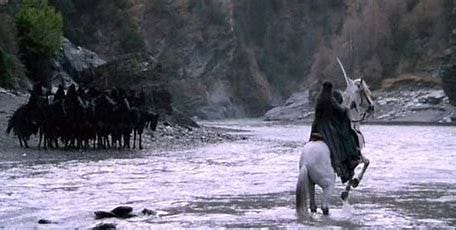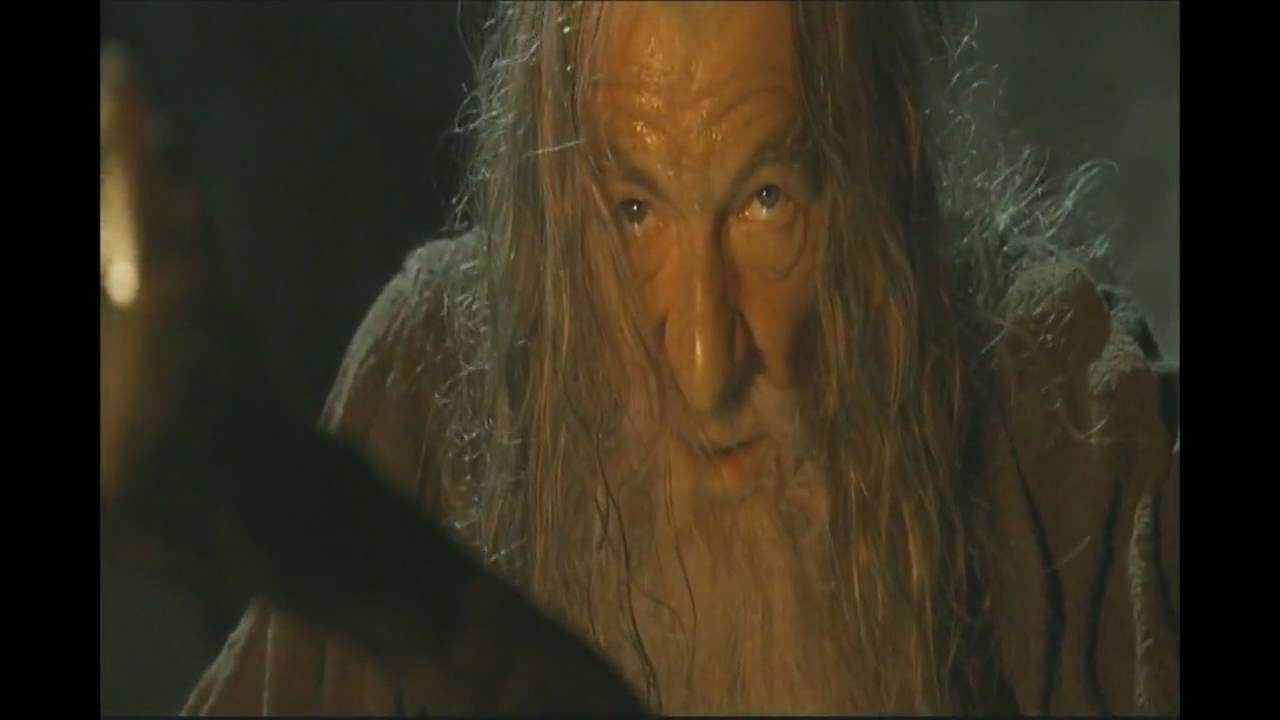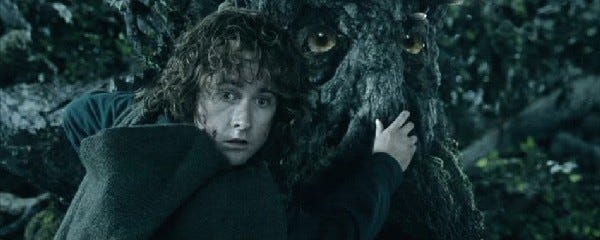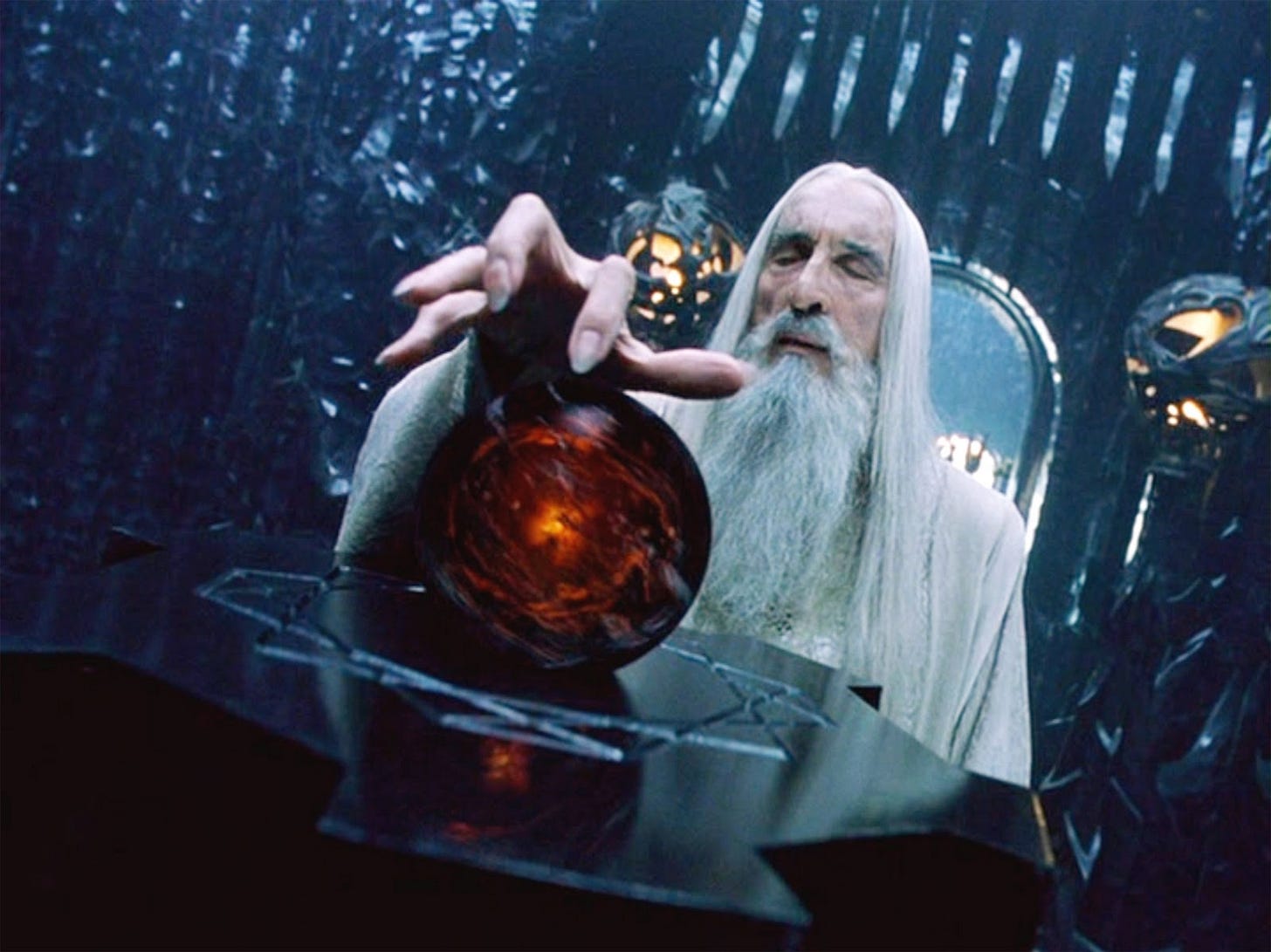The 20 Shots That Define The Lord Of The Rings
A score of extraordinary moments that reveal how Peter Jackson harnessed Tolkien's The Lord Of The Rings
*Quite honestly, there were hundreds I could have chosen
Having delved deeper into the making of The Lord of the Rings trilogy than is entirely good for one's mental health in the writing of Anything You Can Imagine, it has now become next to impossible to watch the films without my mind running through what it took to conjure up each action beat or character moment. With this in mind, I decided go back over the three films and simply celebrate twenty filmmaking (rather than Tolkien) moments that define the trilogy's success. These aren't my favourite moments necessarily (although, I naturally gravitated that way as I wended my way through the films), but those that told their own stories about how Peter Jackson and his team harnessed Tolkien vast fiction on a cinema screen. The list hereby charts a mix of the transcendent, the serendipitous, the guileful, the brilliantly performed, the brilliantly animated and the purely practical.
FYI: running in rough chronological order, they do lean toward Fellowship, which may be a factor of certain choices being the first sighting of a motif or theme. Additionally, as casting was so crucial to the overall effect, and successful beyond even Jackson's wildest hopes, I have attempted to nod toward most of the major performances (apologies to Cate Blanchett's marvellous Galadriel, who didn't make the cut).
1. Smoke Galleons
A touch of wonder, a tincture of featherlight CGI, the depiction of a very old friendship sheathed in quiet grace. Ian McKellen's Gandalf shares a sunset smoke with Ian Holm's Bilbo in the front garden of Bag End before the fateful party, the wizard revealing a more elaborate gift for smoke rings than his diminutive partner with a tiny, silver, spectral galleon launched into the evening air. There is something here of Jackson revelling in two theatrical knights sharing a scene, two great actors who work to such different yet compatible energies together at the start of the trilogy. The conviction and poetry of the films are so swiftly set down. A standard studio blockbuster would abhor the presence of such a 'non-relevant' scene, ignorant of how relevant it really is. There's a terrific little gasp of pleasure from Holm as he watches (a case of imagining on set) this filigree demonstration of wizardly magic, the full extent of which was always elusive. Pipe smoke is a symbol of relief, a chance for reflection. It is by such softer moments that the thrilling set pieces are won.
2. The One Ring
This is all about directorial flourish. Storytelling in images. The chilling confirmation that Bilbo's old ring is indeed the One Ring, instilled with Sauron's life force and a beacon for his many emissaries (cue: the Nazgul stampeding into The Shire), follows Gandalf tossing the tiny heirloom into the coals of a Bag End fireplace. Not only do we see the fiery words aglow on the Ring (a surprisingly tricky VFX process that necessitated having an entirely digital version of the Ring for those shots which reveal the glowing words), but reflected onto the innocent face of Elijah Wood's Frodo like the mark of Cain.
3. Departing The Shire
Let us sing in praise of the late, great cinematographer Andrew Lesnie. Quite apart from the inordinate splendour of the New Zealand countryside and the many felicities granted by digital technology, he gave the films a visual rapture that is entirely his own signature. Take for example, this note of pure cinema: Gandalf and Frodo leaving the Shire at first light, framed in iconic profile against a lilac sky. A crooked wizard's hat as identifiable as any sable fedora donned by one Indiana Jones, along with that teasing outcrop of a wizard's staff and Frodo's scale double (likely the redoubtable Kiran Shah). Whether there was any digital tweaks to the colour — a postproduction grading process overseen by Lesnie and Jackson — matters little, here is a cinematographer's gift for infusing that New Zealand light, unsullied by pollution, with the strange aura of another world.
4. He's Known Round Here As Strider
"... But the gleam of his eyes could be seen as he watched the hobbits." Strider's introduction to the story, such a vivid moment from the book translated with such unerring precision to the films, is layered with greater meaning still. For this, famously, is Viggo Mortensen's introduction to the character and the world of Middle-earth, having stepped off the plane days before and straight into a costume fitting. A week or so earlier, Mortensen had no idea they were even shooting an adaptation of Tolkien's magnum opus or why he should care if they were. And yet, sitting there, enshrouded in his hood and a veil of pipe smoke (combined with a lovely close-up of the glowing weed in the bowl), he is every inch Strider, the weatherbeaten ranger harbouring a noble secret. Those who have partaken of the commentaries will know that Mortensen had a lighter concealed in his palm — a typically practical solution to the issue of keeping the pipe lit. Returning to the film, there is the additional thrill of knowing what both Strider will bring to the story and what Mortensen will bring to the films. There is a widespread misconception that Mortensen's first shot was at Weathertop, brandishing his sword as if born to it, and hurling flaming brands at stuntmen draped in Nazgul robes the size of curtains. Not quite, he began with the Prancing Pony, and Jackson admitted that to his eye those early moments don't quite gel. "I could see he was not yet Aragorn," he told me.... "Have a look at it again in that context." I'm not sure I agree. Whether he is wholly conscious of it yet, there is a telling urgency to Mortensen's delivery, "I know what hunts you" — that echo a man wrested back from the wild, beginning to realise what the emergence of the Ring will mean to him.
5. The River Wild
There was a stage, within the endless back-and-forth of the writing process, when Arwen had been thrust to the forefront of the story, a more than capable elf heroine who eventually joins the heroes at Helm's Deep. Rightly in the end, you feel, they would orientate back towards the book, leaving Liv Tyler's sole action beat the flight to the Ford of Bruinen, where she summons forth the rapids to wash away the Nazgul (for now). Nonetheless, this gives us a brief taste of the action heroine that might have been. Away from the frothing spectacle of the scene, this is about the fierceness of Tyler's delivery. In a canny switch from the book where it is Frodo who confronts the black riders, Arwen (who already stood in for a jettisoned Glorfindel) turns to face her foes on the opposite bank. We first see the horse rearing up and Tyler's stunt-double, raising her sword in defiance, before we cut to the close-up which is all Tyler. Her voice as deep and unwavering as Clint Eastwood she gives the trailer one of its choicest cuts: "If you want him, come and claim him!"
6. The "Constantinople Shot"
Known among the Weta crew as the "Constantinople shot" (given its hints of old Istanbul) this was an unforeseen boon for the filmmakers. Early, binding proof that the camera could cleave to the miniatures without losing the integrity of the shot. Part of Gandalf's recollection, this early sweep past Minas Tirith is almost a teaser trailer for Return of the King. Coated in a shimmer of golden light, we get an early sense of the grandeur of this world as well as its antiquity. It was a clear signal that the miniatures were perfectly capable of representing Tolkien's forbidding architecture, which tended to soar beyond reasonable limits. "You suddenly saw the potential of these miniatures," recalled concept artist and miniatures specialist Alan Lee. "Minas Tirith had only been built for long shots, but they could get within an inch without it seeming fake."
7. The Great Eye Is Ever Watchful
"One does not simply walk into Mordor," warns Boromir, his voice as chilling as a winter wind. "Its Black Gates are guarded by more than just Orcs. There is evil there that does not sleep and the Great Eye is ever watchful." Here's a radical argument for you. The great success of Game of Thrones is entirely down to this little speech edged with dread by Sean Bean's deathly delivery. It's a great introduction to the character and an emphatic report on the magnitude of the forthcoming quest. It's a classic line now, satirised ad infinitum. Which is amazing given it was an eleventh hour tweak — the handwritten rewrites were perched on Bean's knee. The actor's powerful performance as Boromir lead to his future casting as doomed Ned Stark in the George R.R. Martin adaptation, which in turn set a tone for the entire series.
8. Gollum Mk1
The early sighting of Gollum tracking the Fellowship through the labyrinth of Moria is in effect an error. Serkis hadn't even arrived in New Zealand when the shot was done and the great journey toward Gollum was still treading water as a key-frame animation. The fact that Jackson refused to go back and fix the scene for the Extended Editions is almost in honour of the distance Serkis and the Weta Digital team would travel from this point to the character who clambered into sight in The Two Towers. In hindsight, there is something deliciously covert at this shadowy glimpse of the wretch, a tease of the creature we would never see and a living insight of the creative process (and longevity of the shoot).
9. A Wizard Revealed
Naturally, it is Gandalf's booming challenge to a heated Balrog that has launched a trillion gifs. "YOU SHALL NOT PASS!" is thundered with the full bandwidth of McKellen's theatrically-honed voice. But for me it is the building crescendo, the swell of dense Tolkienese that precedes the big line that makes the moment. "I am a servant of the Secret Fire," he growls, imperious under extreme threat, "wielder of the Flame of Anor. The dark fire will not avail you, Flame of Udun! Go back to the shadow." Here, care of Philippa Boyens' influence, we get a small sample the vastness of Tolkien's mythos. No need for explanations (wherefore this "secret fire"?) the words play to those versed in such things and simply add a kind of textural panache to this unveiling of Gandalf's might. Mark the utter transformation from the charming old duffer who clip-clops into Hobbiton to share a quiet smoke with Bilbo, deep fires have indeed welled up to the surface.
10. Gollum Mk2
In my book, I fix upon this midnight hour tête-à-tête between two distinct characters as arguably the defining moment of the entire trilogy, loftily describing it as "a wholly cinematic concentration of Peter Jackson's numinous reach." Which I'll stand by. It is the full entrance not of Gollum, who has been tamed back among the jagged spires of Emyn Muil, but of Smeagol, his timid yet scheming other "half" and the first great flourish of Andy Serkis's double-pronged performance. Beyond the mere technological accomplishment (how swiftly we have forgotten that these are pixels and not flesh), it is the change of angle, facial expression and vocal pitch which facilitate this duologue in one head. It is masterful direction (Fran Walsh as much as Jackson), a cinematic solution to the tricky problem of Gollum's internal world. "He is the only character where you see his thought process working," recalled sculptor Ben Wotton, heavily involved in the evolution of the character(s) from Mk1's more froglike incarnation to the Serkis-infused vision that confronts us in the second film. The hard-won, motion-captured answer to the problem of Gollum and Smeagol embodies the triumph of the whole trilogy — that they found a way. That they trusted they would. Although, Serkis admitted that up until the New York premiere of Towers he still had no idea if it was going to work.
11. The Big Country
The Two Towers has a distinctly different feel than its predecessor. Fractured over three storylines (four and five at times) it is a marvel of editing coherence after the relative linearity of Fellowship. It's the Western of the three, grassy and horse-bound. The wide-open spaces of New Zealand are put to thrilling, redolent use. Has any Marvel or Star Wars film ever felt this alive? There is a wide, wide shot of Gandalf, Aragorn, Legolas and Gimli on horseback, heading — surging is the word — toward Edoras, the mountains falling away in the distance, to the upswell of Howard Shore's army of violins that could be John Ford or Anthony Mann. A certain classicism has been introduced. Yet I would like to flag up (as it were) the resplendent work of art director Dan Hannah, who with his team literally built King Theoden's Saxon-styled capital Edoras on a rocky outcrop surrounded by the Southern Alps. It took eleven cold, windswept months and is justly celebrated as one of the monuments to the crew's ingenuity and determination. "People who lasted the construction period developed very strong characters," Hennah admitted to me. Those winds got up to 140 km an hour.
12. Double-take
There were few in the cast who could pull off a double-take but Billy Boyd had the knack. Pippin had about him the slight sense of being an emissary from the real world, turning a quizzical eye on this grand fantasy. Boyd's dancing performance is a hidden strength of the trilogy. And this on-the-nose (literally) comic moment is the perfect way to lead the film into what is surely the nuttiest of all Tolkien's challenges — Treebeard. It's an admission that the film is prepared to be that nutty. The idea of a species of giant tree-herders made themselves from branches and boughs, with foliage for hair, could easily have tripped up the gravity of the occasion. They could have been cut (down). But Jackson holds true to the book and embraces their exaggerated presence. They loom out of Fangorn, a surreal delight from head to root.
13. Hammer Hero
Despite on occasion proving an intimidating figure on set, the presence of Christopher Lee as turncoat wizard Saruman was a pure, geek boy thrill for Hammer devotee Jackson. But this was by no means stunt casting. Lee brings a formidable poise and conviction to the part (it was the ironclad determination of a Tolkien devotee already convinced of the enterprise's success), working his relatively confined part of proceedings. Barring a stroll in the Isengard grounds with Gandalf, he never leaves the soundstage confines of Orthanc and its hellish pits. This sight of a taloned hand hovering over a Palantir seeing stone (a kind of two-way bowling ball), provides not only a choice sample of Lee's thunderclap of a performance, but some agile plot compression from the writers. Using this ethereal communication, they could evoke the book's elusive partnership between Saruman and Sauron — joining the villainous dots.
14. A View From The Hornburg
As well as his prodigious axe, like Pippin Gimli provides much-needed humour. In John Rhys-Davis perhaps under-appreciated performance we first catch the madcap dichotomy of the dwarves — they are both formidable and ridiculous. For Jackson he was a ready vessel for his own brand of antic humour — the squalls of slapstick familiar to his early splatter movies — offering a welcome chance to puncture the great threat of pomposity. Gimli gives us leave to laugh at the wackiness of Middle-earth. The point in case, a travelling shot along the battlements of the Hornburg (within the great cleft of Helm's Deep) right to left, finding a grumbling dwarf a victim of his stature. It is a chance too to record Orlando Bloom's smirking responses to his huffing and puffing partner, the Hardy to his Laurel (kinda). "It's taking the piss," agreed Boyens on the question of the films being imbued with Jacksonian wit. "And that is Pete's sense of humour definitely. He always says that you don't earn the pathos if you don't make people laugh."
15. The Lighting of the Beacons
The signal travelling to Rohan from Gondor symbolises the full majesty of Return of the King. Jackson can now vault from mountain to mountain across Middle-earth, stirring a tear every time from these wizened eyes.
16. Merry's Fealty
Another perfect lift from the book. Dominic Monaghan's tiny figure (thanks to simple camera angles in this instance), offering his sword to Bernard Hill's King Theoden and Rohan. The wide is wonderful — that sprawling view from Edoras, New Zealand plunging into the distance without any additional digital dressing. But there is a tenderness to the moment too. Merry has found himself cut adrift without Pippin, but more than that is desperate to lend a hand. To be part of something. It is an echo of all those young man of Tolkien's age who willingly signed up for the front in World War One.
17. Horse Lords
For the triumphant, heart-stopping Ride of the Rohirrm, the swelled ranks of swarming software MASSIVE's horse soldiers charging into battle is intercut with close-ups of real horses and real stuntmen and on occasion real actors. Credit here goes firstly to the agile edit, the interplay between live footage and purely CG shots (as in this gif), though it should be noted that a great deal of the digital horse movement had been harvested by motion-capturing real horses and the background plates included genuine parts of New Zealand. All the great battles worked this clever interlacing of different scales. Credit too for Hill's big moment as Theoden, stirring his men, clattering their spears, lifting the audience into the impending thrill. As Jackson always foresaw, film three would be cut loose from exposition into pure pay off. Theoden's white horse the tip of the wedge.
18. Mumak Attack
More of a sequence than a scene, perhaps. While crowned by the flashy balletic of the final 'Leggy Moment' (by now a signature daftness), it the first sighting of the charging beasts that represents Weta Digital in all their third film pomp. Lead by Bernard Hill's exhausted grimace as Theoden, we cut to a line of elephantine giants, a blast of supreme CGI based on the wondrous designs and maquettes of the Workshop, charging toward camera. A sight that is both far-fetched and supremely realistic all at once. It was like a stampede toward the Oscars.
19. The Crying Game
Boyens recalled weeping through the rushes, the footage still raw, not yet blessed with the emotional charge that the score would bring. It didn't matter, she said, Sean Astin's performance as Samwise was enough, lifting his Ring-beaten companion to his shoulders and making that one last drive for the Cracks of Doom. The scenes on the rocky slopes of Mount Doom mark a powerful fusion of Tolkien's World War One experiences, the emotional climax of nine hours of storytelling and sheer performance. Not only Astin's force of will — "Then let us be rid of it... once and for all!" — but Wood's slumped, tormented Frodo (as an actor, he had to travel the greatest psychological distance). This scene has nothing to do with visual effects, or a teeming mythology, it is about the triumph of character.
20. The Departure Of Gollum
It's a showy shot, but well-earned by now. Gollum triumphant — and doomed, the Ring back in his grasp, but he is tottering into oblivion. He doesn't even get the chance to slip it on again before melting away. But in the first moment of triumph we get the shot. The camera (or its digital variation) rising upwards and backwards from that ecstatic face (and who's to know if it is Gollum or Smeagol?), back through the circle of the Ring. It would have made a fitting final shot, but there was work still to be done elsewhere.
So there you have it. I can already think of twenty more I would add. But I would like to hear from you. Which scenes, in filmmaking terms, do you feel define the trilogy? Give me a shout here, or on Twitter: @iannathan2, or on Instagram: @iannathanwriter. Or shout very loudly. We'll get into a discussion type thing.
A Handful of Alternatives
The hobbits confrontation with a Nazgul on the wooden path (the very first scene shot, our introduction to the nature of evil: the snuffling of the creature is truly creepy).
Aragorn v Nazgul on Weathertop (fine Viggo swordplay, early demo of Sam's courage)
Bilbo's Ring lust (biggest jump in the entire saga)
Galadriel and her mirror (Cate Blanchett imperious and frankly quite weird as the elf queen)
Aragorn v Lurtz (heart-stoppingly visceral combat; all hail the stunt choreography)
The Departure of Boromir (Sean Bean's greatest death scene)
Gandalf v Balrog (the vertiginous plunge into the abyss, a scorching opening to The Two Towers)
Gandalf the White (re-enter the wizard, McKellen's whimsical response to meeting up with the old gang a welcome reminder of what he brought to the films)
Saruman's hordes (bobby dazzler of a shot as the camera reverses out of Orthanc and back between the massed MASSIVE ranks of Uruk-hai, based on Nuremberg, a moment set in place by Brad Dourif's awed tears as Wormtongue)
Aragorn returns from the dead (no one has pushed open massive oak door as sexily I am reliably informed, kudos also for Orlando Bloom's half-smile as he greets his old pal, "You look terrible...")
Helm's Deep (just Helm's Deep: the rain, the wall, the monumentality of it all; months of grim night shooting rewarded with pure spectacle)
Drinking games (an alternative moment of prime Gimli/Legolas comedy from the Extended Edition)
Smeagol's terror (caught by Faramir's guards, our sympathy falls on the wretched creature)
The poetics of Master Samwise (Astin's excellence is never far away, here as he desperately impresses upon Faramir what he and Frodo have to do)
Smeagol's birthday (Andy Serkis no less, the intimate story of Smeagol's Ring fuelled downfall)
The passing of Denethor (a burning body plunging from the prow of Minas Tirith like a comet)
Sam v Shelob (hobbit v giant digital spider as envisioned by a true arachnophobe).
"I'm no man!" (cheering from the rafters as Eowyn disposes of the Witch King, Miranda Otto soars into the moment)
Anything You Can Imagine: Peter Jackson & The Making of Middle-earth is out now.
Or if in America, follow this link on Amazon.com

























Where is the shot of the "Bridge of Khazad-dum"?